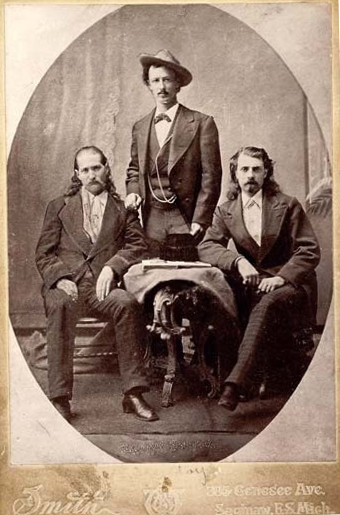Imagine the Three
Stooges on tour in a play about themselves, and you’ll get a hint of this antic
novel about Buffalo Bill Cody, Wild Bill Hickok, and Texas Jack Omohundro. It’s the 1873-74 theatrical season, and while the country’s economy dissolves into another panic, Cody’s troupe of actors turn away eager crowds everywhere east of the Mississippi.
They present two
plays, Scouts of the Plains
and Buffalo Bill! King of the Border Men. Best described as lunatic melodramas, they feature the killing
of large numbers of Indians and dances performed by the Italian entertainer,
Guiseppina Morlacchi.
 |
| Buffalo Bill Cody |
Cody is the
enterprising showman, missing the freedom of his youth as a scout, but married
with kids. Hickok, the older of the two men, is sliding into an alcoholic haze,
darkly given to brawling, whores, and other forms of mischief. Cody keeps him
in the show long after everyone else has begged him to fire the man.
Meanwhile, Hickok
would welcome release from the promise he’s made to stick with the tour for a
year. The clownish fakery of the playacting gets riotous applause but galls the
man who survived the perils of life on the border. The displays of Indian
killing are cheap farce and demeaning. Making this point during a backstage
dispute, he pulls off his costume to show the scars of a gash from an actual
Indian’s lance.
 |
| Wild Bill Hickok, c1874 |
Cody is already
overtaxed by the constant demands of managing his fractious company while busy
meeting and greeting the public. Keeping Louisa happy nearly undoes him. In a
desperate move, he gets her to come onstage during a performance. Instead of
being pleased by the warm reception of the audience, she is deeply embarrassed
and determines to go back to Nebraska, taking the kids.
But this crisis,
too, passes. While real-life Cody and his wife seem never to have been
reconciled, Boggs gives their part of the story a happy ending that is surely a
stretch of his own imagination.
Character. Pivotal between Cody and Hickok is the good-natured ballast provided by Omohundro. Happily married to the danseuse Guiseppina, Texas Jack is sensible and levelheaded. A onetime schoolteacher and bar tender, he helps keep the peace offstage and remembers his lines while onstage.
 |
| Texas Jack Omohundro |
Boggs also suggests
in him a lost innocence, as when he discovers he’s spent a night with a woman
whose son has been forced to sleep outdoors in the cold. He buys the boy
breakfast and gives him all his money in a failed attempt to win the boy’s
gratitude and overcome his own guilt. Then there’s the Christmas he remembers
as the best he ever had, walking the Schuylkill River in Philadelphia with a
13-year-old boy and honing their skill at gigging frogs.
There are hints that
he is losing his vision and his health. His barroom brawls are outlets for his
rage and proof that he cannot be beaten, even by a bunch of oilfield
roustabouts. Through it all, there is the shadow cast by another fatal
shooting, in Deadwood, less than three brief years in the future.
 |
| New York, 1873 |
Boggs has great fun
with this material. Each of the men narrates the story in his own distinctive
voice. Cody’s is brightly good-humored, apologetically self-indulgent,
especially as he confesses his lapses in marital fidelity. But he won’t cuss.
Meanwhile, Hickok is outrageously blunt and the most darkly funny.
In his Author’s Note
at the end, Boggs claims to have taken few liberties with historical records,
though sorting factual from bogus in them is no easy task. The book offers
evidence of the character of contemporary newspaper accounts by introducing
each chapter with a quote, such as this one from the Erie, Pennsylvania Morning
Dispatch:
The drama
has scarce the shadow of a plot and is like an animated dime novel with the
Indian-killing multiplied by ten, but for all that it was heartily enjoyed, and
the bloodier the tragedy the broader was the comedy.
Boggs also provides
a long list of sources for any who wish to pursue the subject further.
First published in
2004, East of the Border is
currently available in paper and kindle formats at amazon, Barnes&Noble, Powell's Books, and AbeBooks.
Further reading:
BITS reviews of books
by Johnny Boggs
Image credits: Wikimedia Commons
Coming up: Good For Nothing (2011)

I got a kick out of this one, too. I've read several of Boggs's books, and they never disappoint.
ReplyDeleteThe guy has a wonderful imagination and a gift with language and character.
DeleteDon't think I've even heard of this one so I'll definitely check it out.
ReplyDeleteI had not either. I came across it in a 2nd hand paperback store this summer.
DeleteRon, this is fascinating. I didn't know Omohundro and Hickok had teamed up with Buffalo Bill on his tours or that they were featured in this book together. Equally fascinating is the real and fictional stories of Cody and Hickok. There is much to read.
ReplyDeleteCody's Wild West show is well known today, but I think few people are aware that Cody started out with this stage show.
Delete